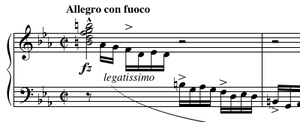Étude Op. 10, No. 12 (Chopin)
Étude Op. 10, No. 12 in C minor, known as the "Revolutionary Étude" or the "Étude on the Bombardment of Warsaw",[1] is a solo piano work by Frédéric Chopin written circa 1831, and the last in his first set, Etudes, Op. 10, dedicated "à son ami Franz Liszt" ("to his friend Franz Liszt").

History
The 12th Étude appeared around the same time as the November Uprising in 1831. Upon the conclusion of Poland's failed revolution against Russia, he cried, "All this has caused me much pain. Who could have foreseen it?"[2]
Unlike études of prior periods, works designed to emphasize and develop particular aspects of musical technique, the romantic études of composers such as Chopin and Liszt are fully developed musical concert pieces, while still continuing the goal of developing stronger technique.
Technique
In the case of Op. 10, No. 12, the technique required in the opening bars is playing long, loud descending runs, which forms a dominant seventh chord introductory build-up to the main theme. The length and the repetition of these rapid passages distinguishes the "Revolutionary" from other études. The rest of the passage focuses on the left hand fingering scales and arpeggios.
Although the greatest challenge lies with the relentless left hand semiquavers, the right hand is also challenged by the cross-rhythms which are used with increasing sophistication to handle the same theme in various successive parallel passages.
The left hand technique in this piece involves evenly played semiquavers throughout. The structure is of the strophic form (A–A′–coda). Some may also argue that it is of the ternary form (A–B–A–coda). The opening broken chords (diminished chord with an added passing note) and downward passages transition into the main appassionato melody. The octave melody's dotted rhythms and the continuous accompaniment give an impression of tension.[3] The piece ends by recalling the opening in a final descending sweep (with both hands) descending to a C major chord, although within a context that draws its expected function as a resolution into question.
Influences
The end of the étude alludes to Ludwig van Beethoven's Piano Sonata No. 32, written in the same key—a piece Chopin is known to have greatly admired – compare bars 77–81 in the Étude to bars 150–152 in the first movement (also ending in C major) of Beethoven's sonata.
In popular culture
DDRMAX2 Dance Dance Revolution 7thMix features a remix of "Étude" called "Kakumei (革命)" as the final boss song, in the One More Extra Stage mode. With the exception of Dancing Stage EuroMix 2, the song is present in every subsequent arcade release. "Kakumei" also appears in beatmania IIDX 7th style and every subsequent beatmania arcade release.
Other uses include:
- Eugene Skullovitch performed this number at the end of Power Rangers Zeo episode 12 "Instrument of Destruction".
- A cover version of this piece is used as the opening sequence music for the UK game show Interceptor.[4]
- Bart Simpson pretended to play the etude in episode The Fabulous Faker Boy of The Simpsons series.
- Was performed in the anime "Your Lie in April" multiple times.
- Was included in the video game Frederic: Resurrection of Music (Video game)|Frederic: Resurrection of Music.
- Was included in the video game The King of Fighters 2003 on the final stage against Adelheid and Rose.
- A remixed mashup between "Étude" and "Minute Waltz" called "Revolution" overrides any other music playing when the character based on Chopin's skill is activated in the mobile game Crash Fever.[5]
- Heavy metal band Lovebites combined elements of this piece and Antonín Dvořák's "New World Symphony" in their 2020 song "Swan Song"[6]
References
- de Korwin-Piotrowska, Sophie (1933). Baldensperger, Fernand; Hazard, Paul (eds.). Balzac et le monde slave [Balzac and the Slavic World]. Bibliothèque de la Revue de littérature comparée (in French). 93. Paris: University of Paris & H. Champion. p. 336. OCLC 489978309.
- Niecks, Frederick (1945), Frédéric Chopin as a Man and Musician, p. 98.
- Kamien, Roger (1997), Music: An Appreciation (3rd ed.), Boston: McGraw-Hill, pp. 231–232, ISBN 0-07-036521-0.
- https://www.youtube.com/watch?v=5o98PI61SGU
- https://www.youtube.com/watch?v=LCQQRkeiSEw
- "LOVEBITES 激ロック インタビュー". Geki-Rock (in Japanese). 2020-01-23. Retrieved 2020-04-30.
External links
- Analysis of Chopin Etudes at ourchopin.com
- Mutopia Project - A public domain engraving of the score using GNU LilyPond, available in several formats.
- Études Op.10: Scores at the International Music Score Library Project (IMSLP)
- Chopin-Godowsky - Etude op. 10, No. 12 played by Francesco Libetta (YouTube)